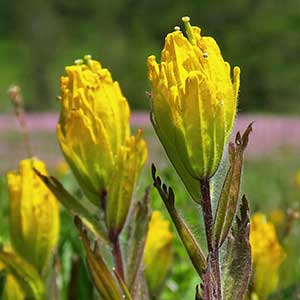Castilleja miniata
Castilleja levisecta
common paintbrush, common red paintbrush, giant red Indian paintbrush, great red paintbrush, scarlet Indian paintbrush, scarlet or common or giant red paintbrush, scarlet paintbrush
golden Indian paintbrush, golden paintbrush
few to many, erect to ascending, rarely proximally decumbent or creeping and rooting at nodes, usually branched, glabrous, glabrate, or hairy, hairs spreading to ± retrorse, short to long, soft to stiff, rarely stipitate-glandular.
few to many, erect, ± decumbent or creeping at base, unbranched, sometimes branched, hairs spreading, medium length and long, soft, mixed with short stipitate-glandular ones.
green to purple, linear to lanceolate, narrowly elliptic, narrowly oblong, or ovate, (1.5–)3–8(–9.5) cm, thin and not fleshy or slightly to moderately thickened and slightly fleshy, margins plane, rarely wavy, flat to involute, whole leaf sometimes recurved downward, 0(–5)-lobed, apex acute to obtuse, sometimes rounded;
lobes ascending-spreading, narrowly lanceolate, apex acute.
green to purple or brown-tinged, linear-lanceolate proximally, oblong-ovate or -obovate distally, 0.8–5.2 cm, not fleshy, margins plane, distalmost sometimes ± wavy, involute, 3–7(–11)-lobed, apex obtuse;
lobes erect to ascending, linear to linear-spatulate, very short, toothlike, usually arising from distal 1/3 of blade, apex rounded.
3–15(–22) × 1.5–5.5 cm, often bearing a thin, white, powdery exudate, especially on bract surfaces;
bracts greenish, scarlet, red, red-orange, or pale orange throughout, sometimes pink, magenta, pink-purple, yellow, greenish yellow, white, or salmon throughout, or proximally greenish, distally colored as above, lanceolate to oblong-ovate, 0–5(–7)-lobed, central lobes sometimes distally apiculate;
lobes erect, linear to lanceolate, oblong, or oblanceolate, short or medium length, arising near or above mid length, central lobe apex obtuse, rounded, or truncate, lateral ones rounded to acute or acuminate.
2.5–25 × 1–4 cm;
bracts bright yellow throughout, or proximally greenish, distally bright yellow, sometimes deep yellow-orange, especially with age, oblong, elliptic, or obtuse to ovate, (0–)5–9(–13)-lobed, sometimes wavy-margined;
lobes erect to ascending, oblong, short to medium length, arising above mid length, central lobe apex rounded, lateral ones rounded to acute.
0–5 mm.
slightly curved, 20–48 mm;
tube 12–26 mm;
abaxial lip usually not exserted, though often visible in front calyx cleft, beak partially to fully exserted;
beak adaxially green to yellow-green or whitish, (9–)14–25 mm;
abaxial lip incurved or ascending, deep green or green, sometimes deep purple or yellowish, reduced, not inflated, visible in front cleft, 0.5–3.5 mm, 5–20% as long as beak (to ca. 33% as long as beak in some populations of var. miniata);
teeth incurved or erect, green or white, 0.7–1.5 mm.
straight or slightly curved, 17–28 mm;
tube 12–15 mm;
beak exserted, adaxially green or greenish yellow, 6–8 mm;
abaxial lip yellow or greenish, reduced, not inflated, 2–3 mm, 25–33(–50)% as long as beak;
teeth ascending to erect, yellow, 0.5–1.5 mm.
colored as bracts, 15–38 mm;
abaxial and adaxial clefts 4–24 mm, 35–70% of calyx length, deeper than laterals, lateral (1–)3–8(–12) mm, 5–30% of calyx length;
lobes linear or narrowly lanceolate to narrowly triangular, apex acute to acuminate or obtuse.
distally yellow, 13–22 mm;
abaxial and adaxial clefts 4–9.5 mm, 30–40% of calyx length, deeper than laterals, lateral 2.5–4.5 mm, ca. 25% of calyx length;
lobes linear to narrowly oblong or narrowly lanceolate, apex obtuse, sometimes rounded to acute.
= 24, 48, 72, 96, 120, 144.
= 24.
Castilleja miniata
Castilleja levisecta
Varieties 4 (4 in the flora).
Castilleja miniata is widely recognized as the common scarlet paintbrush. It is highly variable and has five levels of polyploidy. Nonetheless, it remains fairly well defined morphologically across its wide range. Native Americans use it medicinally. A probable hybrid with C. septentrionalis from southern Nevada was named C. ×porterae Cockerell.
(Discussion copyrighted by Flora of North America; reprinted with permission.)
Castilleja levisecta is listed as threatened in the United States and endangered in Canada, where it is extremely rare. Most of its grassland habitat has been altered by development in the Puget Trough, and there are historical stations in the metro areas of what are now Victoria, Portland, and Seattle. For several decades, C. levisecta was considered extirpated from Oregon. However, recent reintroduction programs in Oregon and Washington have been very successful at reestablishing this species at several sites in the Willamette Valley. The bright yellow inflorescences often gradually age to a golden yellow color, unique in the genus.
Castilleja levisecta is in the Center for Plant Conservation’s National Collection of Endangered Plants.
(Discussion copyrighted by Flora of North America; reprinted with permission.)
1. Bracts distally pale yellowish, pale orange, or salmon, sometimes pale red; n, c British Columbia, adjacent wc Alberta, s Yukon. | var. fulva |
1. Bracts distally scarlet, red, or orange-red, sometimes orange, pink, pink-purple, magenta, pale orange, yellow, greenish yellow, or white; widespread in much of w North America south of the arctic. | → 2 |
2. Stems glabrous or glabrate proximally, hairy medially and distally; leaves appressed-ascending, ascending, or spreading, often thickened and slightly fleshy; calyx lobe apices acuminate; Cuyamaca, Laguna, San Bernardino and e San Gabriel mountains of sw California. | var. oblongifolia |
2. Stems glabrous or sparsely hairy proximally and medially, subglabrous or sparsely hairy distally; leaves spreading to ascending, thin and not fleshy (except sometimes in var. dixonii); calyx lobe apices acute to acuminate or obtuse; widespread in w North America. | → 3 |
3. Leaves linear to lanceolate, narrowly elliptic, or narrowly oblong, apices acute to acuminate, sometimes obtuse; calyx lobe apices acute, sometimes acuminate or obtuse; widespread in w North America, except near coast. | var. miniata |
3. Leaves narrowly lanceolate to ovate, narrowly elliptic, or narrowly oblong, apices rounded to obtuse, sometimes acute to acuminate; calyx lobe apices acute to obtuse; coastal, from extreme nw Oregon northward to British Columbia. | var. dixonii |
- Local floras:
BC,
CA,
OR,
WA
- Local Web sites:
CalFlora,
CalPhotos,
Flora NW,
PNW Herbaria,
Turner Photog.
WildflowerSearch
iNaturalist (observations)
USDA Plants Database
- LBJ Wildflower Center
- SEINet
- Plants of the World Online
- Encyclopedia of Life
- Wikipedia
- Google Image Search


